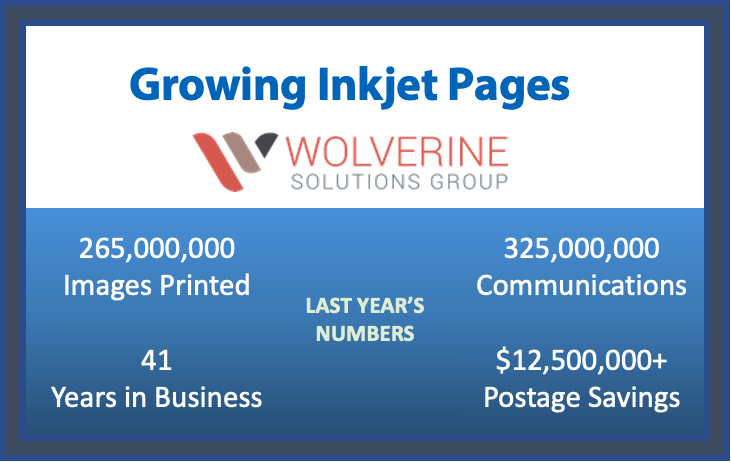Michigan-based Wolverine Solutions Group provides data analysis, direct marketing, printing, and mailing services to customers throughout the United States. Their president, Darryl English, describes their company as a “split shop.” He was referring to the company’s combination of work in transaction printing and direct mail marketing. However, the term could also be applied to their inkjet capabilities which are split between aqueous roll fed and UV sheet fed. Finally, it could apply to the layout of their original operation which had different technologies and processes in separate rooms within their overall shop floor. With the launch of their newly redesigned facility, they have created a unified workflow incorporating inkjet and toner presses along with an array of finishing and mailing equipment in a more efficient layout with room to grow.
Wolverine’s Inkjet Journey
The evaluation of inkjet presses can be a time intensive experience, but the better you prepare for a purchase, the better the results. Wolverine spent 3 years researching presses before selecting a solution because they wanted to make the right decision regarding a press that could print on a variety of substrates, with varying speed and resolution requirements. The selected a Screen TruePress with inline perforating and scoring and UV coating. According to Darryl, “If we had jumped in sooner, we would have made more mistakes. Our investment in inkjet allows us to approach every client, not just one type of client with the press.” Their investment certainly paid off; within the first year that their first Screen Truepress went live, their volume burst from 4 million impressions to 12 million impressions. Wolverine had originally planned to do a field upgrade with Screen shortly after purchase to move to Screen’s latest ink set, but their business did so well that they couldn’t spare the downtime to do a conversion.
Once Wolverine began to reap the benefits of high volume production inkjet, they began to plan for their future growth. They wanted even more flexibility with substrates to enable diversification into new applications and industries. They introduced a Konica Minolta AccurioJet KM-1 LED UV Inkjet Press in order to satisfy the need for heavier media requirements in the direct mail side of the shop and were so pleased with the results that they invested in a second Konica Minolta press within the year. Their diversified approach has allowed them to be successful during the COVID pandemic because their diversification has allowed them to pick up in a new industry when another industry faced a downturn and maintain a consistent workflow. Darryl noted, “No industry is immune to a downturn. For us, when automotive business went down, healthcare went up. Our flexibility has been very valuable.”
Wolverine’s inkjet investment has also allowed them to reduce their overall footprint by trading in 8 toner presses for 3 inkjet presses and has significantly increased speeds and capacity. As their business expanded its inkjet footprint, they looked to streamline their printshop footprint with room to grow. Wolverine has moved into a brand new print space and optimized its open floor layout to efficiently move jobs between presses and finishing equipment. According to Darryl, Wolverine possesses a “football field of inserters.” Their new layout also allows them greater control over their output because they have greater control over air handling, humidity control and other environmental factors that can have a dramatic effect on results. With more room to move, they were also able to work with Screen on the delivery of a new Truepress Jet520HD with time provided to transition to replace the old one, avoiding down-time. They learned a few things about the physical workflow and made some tweaks to the system moving some finishing capabilities off-line to maximize the up-time of the press.
Wolverine has always been keen on optimizing workflows. They are heavily invested in their software front-end and automating every possible process so that they can keep presses running at maximum capacity. According to Darryl, “In order to keep the presses running, if you are going to staff a 24-hour operation, it would be expensive to staff IT the same way you staff operators, so you must invest and have the knowledge set to automate these processes. Jobs at night must just be generated and running on their own. You can’t be constantly quality controlling the files.”
The need for speed in a deadline-driven shop such as Wolverine also necessitates following all the manufacturer’s guidelines for regular cleaning of the equipment. In order to reap the full benefits of a press, according to Darryl, “you really have to pay attention to preventative maintenance. The downtime for regular preventative maintenance is minimal compared to taking the press down and fully cleaning from front to back. You are better off sacrificing time on a regular schedule than having more downtime.”
Darryl sees their inkjet investment as an incredible value add from a profit margin perspective. Their capabilities allow them to be the printer and the mailer which increases their ability to produce timely results. It helps the salesperson pitch a new client because they can emphasize the speed to market. According to Darryl, “We can get things out in the mail quicker and control the whole process rather than doing a portion of the job and waiting on delays from a supplier.” They may be a split shop – but they bring it all together for their customers.

